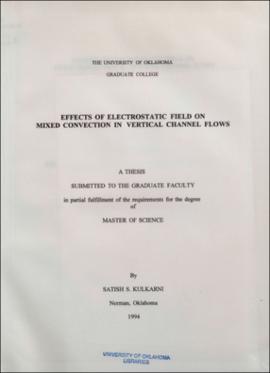| dc.contributor.author | Kulkarni, Satish S. | |
| dc.date.accessioned | 2023-09-18T17:00:24Z | |
| dc.date.available | 2023-09-18T17:00:24Z | |
| dc.date.created | 1994 | |
| dc.date.issued | 1994 | |
| dc.identifier.uri | https://hdl.handle.net/11244/339581 | |
| dc.description | Thesis (M.S.)--University of Oklahoma, 1994. | |
| dc.description | Includes bibliographical references (leaves 132-136) | |
| dc.description.abstract | ABSTRACT
In recent years, the application of electrostatic field to enhance the heat
transfer has been one of the areas of interest. In this thesis, an attempt has been made to study laminar mixed convection under the influence of electrostatic field in a wire-plate vertical channel.
The electrostatic field and space charge density distribution are obtained by
solving Maxwells equation, current continuity equation and Ohm's law
simultaneously. The numerical models by Yamamoto and Kallio for calculating the
electric field and space charge distribution are evaluated. Comparisons of the outputs from both models for one-wire and two-wire channels show good agreement.
For Kallio' s model, lack of symmetry in the distribution of electric field is the main
reason for not being adopted in the analysis of fluid flow and heat transfer. The electric field and space charge density distribution are thus based on Yamamoto' s model. The results are then used in the calculation of electric body forces which, along with the thermal buoyancy, are included in the Navier-Stokes equations. The numerical solution for mixed convection involves computation of vorticity transport
and energy equations. Studies are performed for the simultaneously developing flows in a vertical channel. The flow Reynolds numbers considered are 600, 1200 and 1800 with Grashoff numbers varying from 104 to 106 for both aiding and opposing flows.
It is observed that due to the existence of secondary flows, a combined effect
from the electric field and thermal buoyancy, there is an improvement in the heat transfer for Grashoff number up to 105 in the case of aiding flow. For opposing flows, the heat transfer increases in all the cases of Reynolds and Grashoff numbers.
Oscillation in the flow field has been observed for aiding flows at Re = 600 and
1200 due to the interaction of electric, inertial and buoyancy forces in the channel.
The flow field tends to stabilize if the Reynolds or Grashoff number are increased.
Due to the domination of the flow inertia at Re = 1800, no oscillation has been
observed. | |
| dc.format.extent | xx, 136 leaves | |
| dc.format.medium | xx, 136 leaves : ill. ; 29 cm. | |
| dc.language.iso | eng | |
| dc.subject.lcsh | Electrostatics | |
| dc.subject.lcsh | Heat--Convection | |
| dc.subject.lcsh | Fluid dynamics | |
| dc.title | Effects of electrostatic field on mixed convection in vertical channel flows | |
| dc.type | Text | |
| dc.contributor.committeeMember | H. Sutton, William | |
| dc.contributor.committeeMember | Altan, M. C. | |
| dc.contributor.committeeMember | Lai, Feng-Chyuan | |
| ou.group | The School of Aerospace and Mechanical Engineering | |
